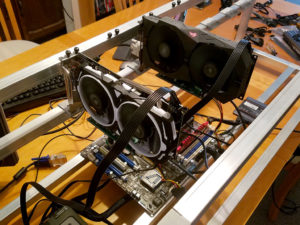
Building an open-frame GPU miner.
It’s finally time for an update to my popular 2013 Litecoin mining guide! It’s four years later, and Ethereum mining is where it’s at for GPU miners, so that’s what I’ve focused on. I’ve kept the same format and detail level as my old guide, so if you were around back then, you’ll know what to expect.
If you’re new to the world of crytocurrency mining, this guide should give even an absolute beginner all of the knowledge needed to put together an efficient Ethereum (or other GPU-minable altcoin) mining rig using readily-available consumer hardware.
This guide will be broken into several parts, each focusing on a different aspect of building your first mining rig. First, let’s take a look at what you’ll need in terms of hardware to put a respectable Ethereum miner together.
Build your own Ethereum Mining Rig, part 1: Hardware
Here is the list of hardware that I recommend. Don’t worry if you’re not able to get exactly what’s on this list, I provide some excellent alternatives below the table.
| Motherboard | 1 x Asus B250 Mining Expert | $180 |
| Processor | 1 x Intel Celeron G3900 CPU | $45 |
| Memory | 1 x 4GB DDR4 DIMM | $40 |
| Power Supply | 1 x 1200w Platinum PSU | $260 |
| GPUs | 3+ Radeon RX 570 video cards (*see below) | ~$200 each |
| Boot Device | 1 x 60GB SSD -or- USB stick (Linux) | $5 – $35 |
| Case | 1 x build your own (see bottom) -or- open frame case | $30 – $200 |
Some explanations and alternatives for each item:
Motherboard
Generally, any motherboard with PCIe slots on it is suitable for mining—typically one GPU per PCIe slot. The PCIe slots don’t need to be full-length, as we can attach GPUs to 1x slots with the help of risers. With that said, there are potentially some limitations when you start to pack a large number (4+) of GPUs onto one motherboard, even if that board has enough PCIe slots to physically accommodate them. That’s why picking a suitable motherboard is probably your biggest hardware headache if you want to run as many GPUs as possible in your rig.
My top choice is currently the Asus B250 Mining Expert board. It’s literally made for mining, with support for up to 19 (!) GPUs and 3 power supplies right out of the box. Even if you don’t intend to initially run more than a few GPUs, the included mining-centric diagnostic features and ability to expand later probably make the price premium over less-robust boards worth it.
The ASRock H110 Pro BTC+ is another excellent choice for mining, with support for up to 13 GPUs. However, it currently costs about the same as Asus’s mining board, and for the money I’d rather stick with Asus. If you know that you’ll definitely stick to a single PSU and a small handful of GPUs (e.g.: the majority of us), this is a fine choice, especially if you find a deal on it.
Finally, the Biostar TB250-BTC is also aimed at miners, and costs considerably less than the Asus and ASRock offerings. The Biostar board “only” supports 6 GPUs, but that’s likely all that the majority of us need. If price is your primary consideration, the TB250-BTC should be at the top of your list for 6 GPU rig builds.
If you only want to use 3-4 GPUs in your rig, then you’ll have a much easier time. Most boards with up to four PCIe slots should accommodate a GPU in each. Keep in mind that you can use old hardware that you have sitting around—the board doesn’t have to be recent. I dug out an old ASRock 970 Extreme4 that I used four years ago for litecoin mining, and it still works fine today for up to 4 GPUs (5 is possible with some work). So it’s possible to pick up an ancient board on eBay/Craigslist for nearly nothing and mine with less than 6 video cards.
CPU / Processor
This one is easy: buy the cheapest CPU that works with whatever motherboard you pick. When it comes to mining, the GPUs do all the work. Your CPU will essentially sit idle, so there is no reason to waste money on anything other than the bare minimum.
All of the motherboards that I recommended based on Intel’s LGA 1151 socket, so that means the Celeron G3900 is probably the best choice.
If you go with an AMD motherboard, a Sempron CPU will do nicely.
Memory
4GB is fine. Overkill really, at least for Linux. If you have an old 2GB stick (or even 1GB!) sitting around and plan to run Linux, you’re good to go. If you want to run Windows, then 4GB is probably a realistic minimum.
While Ethereum mining is pretty memory-intensive, everything happens on the GPUs. System memory will be pretty much unused, so there is no reason to spend money here, especially with DDR4 prices so high.
PSU / Power Supply
The power supply is extremely important—don’t skimp on it! A good, efficient PSU will keep your electricity costs to a minimum and more than pay for itself over the long run. Seasonic, EVGA, and Corsair are all generally top brand choices. The 1200W unit that I’ve linked may seem like overkill, but power supplies are most efficient when they’re not running near their rated maximum load. A 6 GPU rig will draw about 750 watts (assuming 6x RX 570 cards, properly optimized), which means a 1200W PSU will have sufficient headroom to perform efficiently.
If you’re planning on running only 3-4 GPUs, you can save a bit of money and go for their 850 watt model instead.
GPUs / Video Cards
The top Ethereum mining choice is currently the Radeon RX 570 / RX 580 line*. The RX 570 delivers nearly the same performance as the RX 580 (within 4-7% or so) for a bit less power consumption—they’re essentially equal from an efficiency standpoint. The RX 570 is usually significantly cheaper than the 580, so generally the 570 is the best choice.
Which model to pick, though? While literally any RX 570/580 card will do, the most important thing to look for is memory speed if you want the best performance. Cards with a higher memory clock speed will generally perform a bit better while mining ETH (and can generally be overclocked more). Memory capacity isn’t really important beyond 4GB, so all other things being equal, there is no reason to shell out extra cash for the 8GB version of a card. It’s true that every GPU needs to be able to hold Ethereum’s DAG file in memory, and that file is slowly increasing in size—but it won’t surpass 4GB until late 2019 (and ETH’s switch to PoS will likely occur before then, anyway).
With all of that said, the 8GB versions of the cards tend to have faster-clocked memory than most of the 4GB cards, so if the price difference isn’t too large, spring for whatever is the fastest. Most of the cards fall between 1650 Mhz (6600 Mbps effective) to 2000 Mhz (8000 Mbps effective). The slower 1650 Mhz memory GPUs will hash at 21-23 Mh/s, and the fastest 2000 Mhz ones will do 25-28 Mh/s (both can potentially be pushed higher with BIOS mods and good luck).
The best advice is usually to just pick up whichever 570/580 card you can get your hands on for the least money, as mining speed differences between brands/models are pretty small after optimization. These 8GB MSI RX 570 cards are $220 each as of 11/29/2017, and I’m running mine at 28 Mh/sec without pushing them too hard.
If you can still find old RX 470/480 cards on the secondary market, they’re just as good the RX 570/580 cards that replaced them.
*While my guides deal with setting up and optimizing AMD’s GPUs, nVidia’s 1060 / 1070 video cards are also excellent for mining. Generally these days I tend to recommend whichever is cheaper (and right now, that’s AMD). But if you find a deal on some nVidia 1070 GPUs, don’t hesitate to grab them—they perform just as well as AMD’s offerings, and are arguably easier to set up (just remember to install nVidia drivers instead of AMD’s if you follow the rest of my guide!).
Boot Device
If you plan to run Linux, you can use pretty much anything, including a ~$5 16GB USB stick (we’ll be using Claymore miner, which doesn’t write Ethereum’s DAG file to disk, so we don’t need to worry about wearing a USB stick out due to constantly writing to it, like with the stock ethminer). With that said, SSDs are pretty cheap nowadays and it might be nice to have one in case you want to try Windows at some point.
If you plan to run Windows, then a cheap 60GB+ SSD is your best bet. If you have an old mechanical hard drive laying around, that’ll work fine too.
The Case
I highly recommend against trying to cram a bunch of GPUs into a conventional PC case. You have two realistic options here: buy a purpose-built mining frame, or build something yourself.
The first option is straightforward, if not a bit more expensive. Here is an example of an open-air frame that will accommodate up to 6 GPUs. Here’s another option. You’ll pay a premium going this route, but it’ll save you some time and effort.
Building your own is much cheaper, and (arguably) more fun! If you’re handy, you can put together a simple aluminium frame yourself for a fraction of the cost of buying one. If you don’t have the necessary skills or tools for that, I popularized building mining rigs inside plastic crates back in 2013, and that still works fine today (for up to 4 GPUs or so, anyway). At the bottom of this post, you’ll find instructions on how to build a plastic crate “case”.
Risers & Miscellaneous Stuff
If you’re building your own case (whether it’s from a plastic crate, or aluminium, or something else), you’ll need risers to connect your GPUs to your motherboard. If you’re buying a mining frame, most include risers. Risers tend to be pretty misunderstood among new miners, so here is what you need to know:
- Risers can be powered or unpowered. A riser is unpowered if it simply connects a GPU to a motherboard PCIe slot. A riser is powered if it additionally accepts power from the PSU (generally via a molex-type connector). Unpowered risers allow GPUs to receive up to 75 watts of power through the motherboard’s PCIe bus, just as if they were plugged in directly. Powered risers will take that additional power directly from the PSU instead, bypassing the motherboard.
- You may mix unpowered and powered risers, but the total number of unpowered risers should not exceed two (this includes GPUs plugged directly into the motherboard)! Motherboards are generally not designed to deliver more than 150 watts of total power through the PCIe bus, so two GPUs on unpowered risers is the safe maximum (2 x 75 watts).
- The newer USB-style powered risers often include SATA-to-molex power adapters. Throw these adapters away! SATA plugs are not designed to deliver 75 watts safely, and these can get hot enough to potentially be a fire risk (admittedly, 99% of the time you’ll be fine, but it’s not worth the risk). Instead, connect the molex plugs on the riser directly to your PSU (no more than two risers per PSU plug). Newer versions of these USB risers forego the molex adapter and instead use a PCIe connector for power.
I do think the newer USB-style risers are the way to go—they’re longer and easier to work with than the old ribbon-style cables. Here is a 6-pack of USB risers with the newest (and safest) PCIe connectors. It’s always smart to buy an extra or two, as defects are relatively common. If you have older ribbon-type risers laying around, or can get them cheaply, they’ll work just fine.
If you’re building or buying a large frame, you might need extenders for some of your molex plugs and PCIe power plugs.
You’ll also need a power button, unless your motherboard has one built in (which is fairly rare). This will do the trick, or you can build one into your plastic crate if you plan to go that route (see below).
Some people have reported that their rigs won’t boot unless they have a monitor connected, although this seems to be fairly rare (my own rig boots fine without a display attached). If this happens to you, you’ll need a dummy plug.
Building your Mining Rig “Case” from plastic milk crates
(I’ve copied the instructions from my original 2013 guide here and updated them slightly.)
Here is what you’ll need to create a simple DIY plastic crate housing for your miner:
| Plastic milk crate (can stack two and put your PSU in the lower one) | $10 each |
| Plastic stand-offs | $3 |
| 6 x #4 3/8″ wood or metal screws | $1 |
| Brace to rest GPUs on (1″ PVC pipe works great!) | $2 |
| a few cable ties (8″ or so) | $2 |
| power switch & LED (optional) | $5 |
You can get plastic crates in most home improvement stores if you don’t want to ship it from Amazon (it’ll be cheaper, too!). I picked mine up at Lowe’s for under $5 each. You should be able to get everything else on the list at Lowe’s if you happen to have one near you, too. As far as tools go, you’ll need a drill and a knife capable of cutting into whatever plastic crate you buy.
Assembly Steps:
First, attach your CPU & heatsink/fan to your motherboard, and place your RAM into the memory slot(s). Then follow the general steps below to mount everything into your plastic crate.
Click the images for a close-up look at each step.
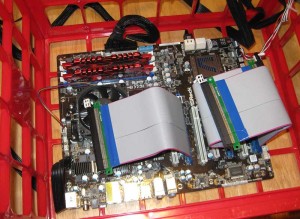 Place plastic standoffs on the bottom of your plastic crate, and rest your motherboard on top of them. Make sure that all of the essential ports are accessible (SATA, USB, keyboard, mouse, etc). Use your knife to cut away pieces of the crate if necessary so that all ports you plan to use are exposed. Then plug your riser cables into the PCI-E slots of your motherboard.
Place plastic standoffs on the bottom of your plastic crate, and rest your motherboard on top of them. Make sure that all of the essential ports are accessible (SATA, USB, keyboard, mouse, etc). Use your knife to cut away pieces of the crate if necessary so that all ports you plan to use are exposed. Then plug your riser cables into the PCI-E slots of your motherboard.
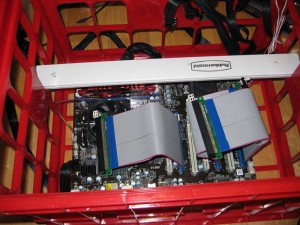 Place your brace (1″ PVC pipe is really ideal and won’t flex over time) so that it is sitting above the motherboard, high enough for your GPUs to rest on. Cut the brace so that an inch or two sticks out on either end of the crate.
Place your brace (1″ PVC pipe is really ideal and won’t flex over time) so that it is sitting above the motherboard, high enough for your GPUs to rest on. Cut the brace so that an inch or two sticks out on either end of the crate.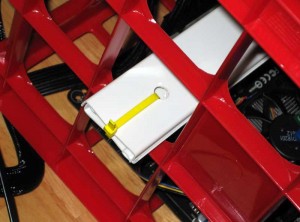 Drill holes in your brace so that you can secure it with cable ties (see image). Do not simply rest the brace on the crate! An accidental bump can cause it to fall into the crate, along with ~$1000 worth of GPUs if you do that!
Drill holes in your brace so that you can secure it with cable ties (see image). Do not simply rest the brace on the crate! An accidental bump can cause it to fall into the crate, along with ~$1000 worth of GPUs if you do that!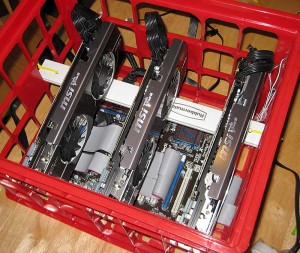 Connect each GPU to it’s corresponding riser cable, resting the bracket end on the lip of the crate and the other end on your brace.
Connect each GPU to it’s corresponding riser cable, resting the bracket end on the lip of the crate and the other end on your brace.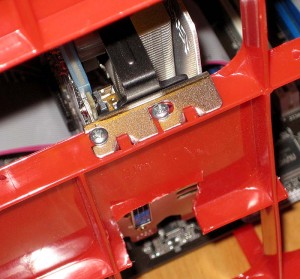 Screw each GPU down into the lip of the crate. If you drill small pilot holes ahead of time (mark where to drill with a sharpie), this is much easier.
Screw each GPU down into the lip of the crate. If you drill small pilot holes ahead of time (mark where to drill with a sharpie), this is much easier.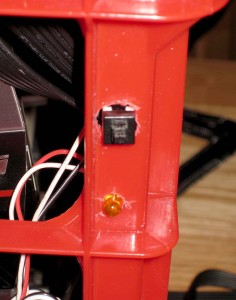 If you have a power switch and LED, mount them into one of the crate’s corners. I was pretty sloppy with mine, but it’s functional.
If you have a power switch and LED, mount them into one of the crate’s corners. I was pretty sloppy with mine, but it’s functional.
You’re done! Simply connect everything to your power supply and you should be ready to power your rig on for the first time. If you have a second crate, you can put your power supply in there (along with your harddrive if you’re using Windows), and stack it under your main crate to save some space.
In the next part of this guide, I’ll show you everything you need to do to start mining under Linux (or skip to the Windows section if that’s more your thing)!



 April 6th, 2017
April 6th, 2017  CryptoBadger
CryptoBadger 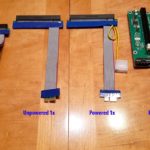
 Posted in
Posted in  Tags:
Tags: 


Hi,
It’s hard to find one of the graphics card mentioned in the thread. What are you thoughts on the MSI Gaming GeForce GTX 1070 8GB GDDR5 SLI DirectX 12 VR Ready Graphics Card (GTX 1070 GAMING X 8G)?
Any GTX 1070 is a fine choice. They’re about as fast as a RX 570/580 for ETH mining.
Since they are more expensive, will this system work with a single nvidia GTX 1070? Is there a difference between having 3 less powerful GPUs vs having one more powerful GPU? Thanks!
The GTX 1070 will work fine (either a single card, or multiple). The GTX 1070 is about the same speed as the RX 570/580 for ETH mining. Buy whichever is cheaper for you (currently, the RX 570/580 is sold out everywhere, so the 1070 is probably your best bet).
CryptoBadger, thanks for this very useful guide. Do you think that at this point 1070 would be a safer bet then rx460/470?
Also what do you think about using multiple smaller psu’s for a beginner rig?
Yes, the GTX 1070 is a fine alternative, given that the AMD cards are out of stock everywhere.
I don’t really recommend multiple PSUs, especially for a beginner, due to the risk of hardware damage if wired incorrectly. A single high-wattage PSU is safer, and probably less expensive.
Can’t find any GPU at decent price besides Radeon 560. What will be the performance difference to the 570? Thanks
The RX 560 is much slower (about 12 MH/s). I don’t really recommend it for mining, although it’ll work.
Will this GPU work fine with my setup?
ASUS Radeon RX 560 4GB ROG Strix
Grafikkort, PCI-Express 3.0, GDDR5, 1285/1275MHz, Polaris.
regards Peter
The RX 560 will work, but you’ll have disappointing hashrates compared to the RX 570/580. I believe the 560 gets about 12 MH/s (eg: the RX 570 is about 250% faster).
Dear crypto guy, what do you think about this:
I have an old hd7870, and I can buy three more for around 50$ a piece. I have an asrock970 pro3 r2.0 motherboard with a fx4170 and 8gb of ram. Also i have a 60gb ocz ssd.
Could it be an efficient mining rig, and what psu should I buy? I dont need this pc any more, cuz I have notebook and this is just sitting around. And the most important part, I dont have to pay for electricity cuz I live in a dorm and I just pay for rent.
So would it be profitalbe?
4x hd7870 sapphire dualx cooler for 150$ and a good psu for around 120-150$
My investment is around 300$, and no electricity bills!
I cant buy any new gpus cuz they are overpriced or sold out.
Thanks man 🙂
can i use 6x 1050Ti?
Hi,
I am planning to build a 6 GPU rig …
here are hardware specs… please provide your feedback if I need to change anything….
1) Motherboard: Asus Prime H270-Plus Intel LGA1151 ATX Motherboard DDR4 M.2 VGA D-SUB DVI HDMI
link : https://www.asus.com/au/Motherboards/PRIME-H270-PLUS/
2) CPU : Intel Pentium G4560
link : http://www.ebay.com.au/itm/Intel-Pentium-G4560/252982019823?ssPageName=STRK%3AMEBIDX%3AIT&_trksid=p2057872.m2749.l2649
3) RAM: Kingston 8GB DDR4 2400MHz PC4-19200 CL17 288pin Non ECC Desktop Memory RAM 1.2V
link : http://www.ebay.com.au/itm/Kingston-8GB-DDR4-2400MHz-PC4-19200-CL17-288pin-Non-ECC-Desktop-Memory-RAM-1-2V-/262721174271
4) SSD : ethos usb – 16GB
5) PSU : eVGA SuperNOVA P2 1000W 80PLUS Platinum Power Supply[220-P2-1000-XR]
link : https://www.evga.com/Products/Product.aspx?pn=220-P2-1000-XR
6) Riser : USB 3.0 PCI-E Express 1x to 16x Extender Riser Card Adapter Power Cable Mining
7) GPU : sapphire radeon nitro+ rx 580 8gb X 6
link : http://sapphirenitro.sapphiretech.com/en/580-LE.html
Cheers,
I think you would need more than 1000w for 6 gpu’s. Go for 1200w platiumn
Thank you
Buy two psu don’t just get one run them in tandem
Also look up 580 reviews for mining garbage
Nice article. How long mining on Gpu will work?
The interest in mining doesn’t seem to be slowing down, the global shortage of mother boards and GPu’s seem to suggest it’ll be going for a long time. Plenty of people building rigs..as am I.
What do you all think about AMD’s new Rx Vega GPU’s? Would it be wirth it to mine with them?
I’m using a flat piece of wood for my base. Would you suggest something between the bottom of the motherboard and the wood?
Thanks, great guide!
I put rubber spacers on mine , Home Depot or lowes has
Is the Biostar TB85 a decent option for motherboard. Really just looking for a chipset that does not require any BIOS tweaking when connecting GPU’s.
The Asrock extreme4 970 mobo did not require me to do a thing but plug and play. But i have not Overclocked my GPU’s…yet
Cool. Ill check it out. Thanks
What GPU’s are u running with this mobo?
I have 6 gtx 1070s running on a TB85 with Windows 10 and did zero changes/updates with the mobo and have been working fine.
So i want to build a rig, ive found all the parts apart from the gpu, i cant decide between rx570s, 1070s, 1060s.
I can get rx570 sapphire nitro+ 8gbs on amazon for 200£ but i saw somewhere that they wont be released until September? Any other options?
Im too worried about the dag file size hashrate reduction by then so thats why I looked into nvidia cards.
I thought about buying 1070s but i dont know which is the best one and theyre quite expensive
I wont be able to build my rig until mid August since im going on holiday, but i want to get it finished before September.
I need a second opinion about which card i should choose, which coin i should mine, and if i should even bother with ethereum at this point and maybe go zcash instead. (with nvidia)
I have the 1070s and getting 30m/hs per card. I have 6, will add a 7th later. As my mobo supports 7
may i ask what mining software you use and did you do any oc or other adjustments with the 1070s? Mine are running around 25-26 each. Thanks
Hi House,
I am really frustrated right now and I need help ASAP. below is my Rig built and once I on it. it turns off and on after few seconds. I detached everything one after the other till it was remaining only the mobo and PSU and its still doing thesame thing. What can I do? Thanks guys.
1. Seasonic Flagship PRIME SERIES SSR-1200PD 1200W PLATINUM FULL MODULAR ATX12V & EPS12V 135mm FDB Fan Super Quiet Power Supply
————————————————————————————————–
2. Intel Celeron G1840 Processor – BX80646G1840
——————————————————————————————–—————————-
3. DREVO X1 Series 60GB SSD 2.5-inch Solid State Drive SATA3 Read 500MB/S Write 90MB/S
—————————————————————–——————————————————–
4. Kingston HyperX FURY 8GB 1600MHz DDR3 CL10 DIMM – Blue (HX316C10F/8)
————————————————————————–———————————————–
5. Gigabyte GA-Z97X-GAMING 7 LGA 1150 Z97 Gaming Audio Networking ATX Motherboard. (used one)
***Slots: 3x PCI-Express 3.0 x16 Slots (one runs at x8, one runs at x4), 3x PCI-Express 2.0 x1 Slots, 1x PCI Slot.
————————————————————————-
6. 3. EVGA Geoforce GTX 1070
1. EVGA GeForce GTX 1070 FTW
Check to see if power supply is issue. Do the psu “paperclip” test and see if it stays on or not. Then you’ll know if it’s the psu.
Thanks for the reply, I have ordered a PSU testing jumper. I dont know why it didnt come with Seasonic 1200 PSU i bought. I am recieving it today. I will update you after testing it. But I am already shopping for another mobo, I cant wait for the return and shipping again. I think I will be going for Biostar Motherboard TB250-BTC. In that case, I will need to buy a 8GB Single DDR4 2400 MT/s (PC4-19200) DIMM 288-Pin. Based on Cryptobadger analysis. I will be updating you… Thanks!
Hii can you please help me with my issue
I’ve just bought Asus RX 480 8G Gaming with asus H81 M-K (MotherBoard)
Every time I start claymore I get black screen and my computer stops (frezz)
PSU (550W)
All my drivers are up to date
all i want to know does this mother board causes this issue??
I’m using a Samsung 120gb SSD card for my drive. My motherboard came with SATA cables, but I already own an SSD to USB adapter. Can I use that as my connection to the MB?
THanks.
Hi Guys
Whats about the ASUS STRIX R9 390X?
I’ve got one in my rig and will buy another one 🙂
good idea or not?
I have 10 powered risers all appear to be duds.
I’ve bought new USB 3 cables for testing.
Mixed and matched 1xusb adapter’s to different 16xrisers, tried various combinations of gfx card configurations 1 in pcie16x, 1 via riser, All via risers etc.
1000w platinum psu.
Tried 3 different motherboards, latest bios, oldest bios and bios somewhere inbetween.
I’ve even tried the shorting of pins on the 1xpcie on the mobo.
Are they all duds or have I missed something?
Are you powering the risers? I didn’t see that mentioned in your list.
Yes, I have tried them powered and unpowered. Using the sata power adaptor and also ditching the adaptor and going straight molex.
Tried powering a single riser and gfx card on the same cable and on their own cable as well.
These are gtx1070s that I am using, also tried 2 older 270x cards. I have grabbed a couple of rx580s today so I will try them when I wake up. Time for bed after a night shift.
They can’t all be broken surely. Maybe I just have bad luck.
I assume you are turning the system on? Lol
None of the gpu fans spin or light up at all? Does your cou fan spin? Everything else works except the gpus?
I am building a 6 GPU rig based on this case linked below. The PSU seems only for the GPUs so I still need another one? Should I also buy one of the 1200 watt PSUs that you mentioned in the build?
http://www.parallelminer.com/product/rev2-cooled-all-aluminium-6-1-gpu-open-air-mining-case-w-6-usb-risers-1-1200w-psu-kit-eth-zec-xmr-dash-with/
So I cant get my hands on any 1060s because they’re so expensive..whats the thoughts on 6x gtx 1050 Ti? is it worth spending that money..also whats the thoughts on mining Monero..I dont see it really mentioned here.
Hi
I have pretty much setup everything right now and plugged in all the hardware right. Setup the bios right, but I’m still getting nothing on my screen, while the computer is on. Am I missing something?
Can you please help me out.. can’t figure it out.
First question. How do you know you setup the bios right if nothing shows on the screen or did it at one point?
You have the display plugged into gpu and not the mobo video? The onboard graphics will be disabled with the gpus connected
I had the windows all setup before plugging in the GPUs. Should I setup windows again all the gpus plugged in?
I had windows setup before all the gpus were plugged in. I had all the motherboard drivers and windows all updated. Plugged one gpu to get the driver to work.
Should I formatted and install all the gpus and then install windows?
You shouldn’t need to reformat windows. You still have your monitor plugged into the same gpu? Wondering if bad card or slot or riser? Maybe try just the one gpu that worked and see if windows will load again? Then try adding one gpu at a time?
So I plugged in all the graphic card(nvidia 1070) directly to the motherboard (one at a time), works fine. Risers are all new, but don’t know how to check to see if they are fine.
I plugged everything in and still blank screen.
I have 1 molex cable to the psu(1200w), but 2 riser connected to 1 molex cable, thinking that I should mix it up with sata connection?
Or thinking that not enough power….
You still haven’t answered a few things. Do you have your monitor plugged into one of graphics cards or the motherboard? The on board graphics will be disabled so you need to plug into graphics card. Did you try turning it on again with just the one graphics card that worked originally to see if screen would show up? And if that does work then add one at a time and make sure it still works (able to turn on and see screen after each additional card added) until you find the problematic one.
These are my specs:
Biostar TB250-BTC
4gb Ram
120 ssd
i3-6100T 3.2 Ghz lga1151 35w
6x geforce 1070 gigabyte
6x v007 riser
Evga 1200w PSU
I have plugged monitor into the graphic card that goes into the 16x slot on the motherboard. And nothing shows up. I tried plugging 1 graphic card with riser into the 16x slot and still nothing shows up. But when I plug the graphic card directly into the 16x slot it works fine.
I have 1 molex cable that has 3 attachments, Can I connect 2 riser to, this should be fine, right?
I have 2 risers per molex cable and mine works. Sounds like a bad riser possibly if the card works directly in the 16x slot but not connected with riser. Have you tried all the risers with just the one gpu to see if you can get display?
Yes, I have went thru with each riser with each graphic card, and nothing display. I had a same thing with a MSI z170a-sli plus board… so maybe not enough power?
It might not be enough power? Do the cards look like they have power when you boot? Did you try each riser with only one card connected to make sure the risers work? Because you said the monitor displayed with the gpu connected straight to the 16x slot but not with the riser… Was that the only gpu connected or that was with all of them connected? If it worked with all gpu connected I would think bad riser, but could be too much power. I’m not sure how much extra power the risers use themselves. And I have mine on two 850s so I can’t help you out there. And I read another forum talk about using hdmi instead of vga if you are using vga you might try that.
When I have it powered all the graphic card fans turn on, but then shut off sometimes and comes back on. This is the reason why I guessing that it doesn’t have enough power.
I went thru with each riser, and all ok…
What worked was resetting the CMOS… smh.. All 6 1070 CPU working!!!
Awesome! Sorry I couldn’t help out more. Funny though I just read another thread earlier about resetting cmos. Was gonna mention that or see what version of windows u had cause some don’t support 6 gpu. But glad you got it running. Good luck!
And not sure how many cards you have? But if you only have two one molex cable is fine and I have mine directly to risers with molex not sata. And 1200w should be plenty if all you have is 2 cards
Can I use any graphic card?(have a lot of low powered ones available for cheap)
Hi guys,
I built my rig with 4 gtx 1070 and I am facing issues can anyone please have any suggestions…
Here is the thread https://forum.z.cash/t/4-gtx-1070-msi-z170a-m5-and-windows-7-mining-rig-challenges/19036/12
Not sure what happened..
PSU – 1000w EVGA 1000GQ
MB – ASRock B150M Pro 4
RAM – Kingston Technology ValueRAM 4GB 2133MHz DDR4
CPU – Intel BX80677G3930 7th Gen Celeron Desktop Processor
GPU – EVGA GeForce GTX 1060 GAMING, ACX 2.0 (Single Fan), 6GB GDDR5, DX12 OSD Support (PXOC), Only 6.8 Inches Graphics Card 06G-P4-6161-KR
Power Button – uxcell 67″ Desktop Computer Case Power Supply Reset HDD Button Switch
Started with one GPU, had my SSD drive with windows 10 loaded and I couldn’t get anything to appear on my monitor. Powered down. Removed my GPU to allow the monitor to connect to the MB graphics, restarted. Heard a loud “pop”, saw sparks and smoke from the PSU and now it’s dead.
Thoughts?
If the PSU is brand new, it’s likely a defective unit vs something that you did. It happens – hopefully you’ve already dealt with the RMA and have a new unit in hand (or at least on the way)!
Defective. Plugged in the new one and everything is fine. Well sort of. I can’t get a signal to my monitor.
PSU – 1000w EVGA 1000GQ – Plugged in and working
MB – ASRock B150M Pro 4
RAM – Kingston Technology ValueRAM 4GB 2133MHz DDR4 – Removed, reinserted.
CPU – Intel BX80677G3930 7th Gen Celeron Desktop Processor – Removed, reinserted, fan spinning
GPU – EVGA GeForce GTX 1060 GAMING, ACX 2.0 (Single Fan), 6GB GDDR5, DX12 OSD –
fan spins, then stops
Power Button – uxcell 67″ Desktop Computer Case Power Supply Reset HDD Button Switch – works, turns everything on just fine
The only variable I can see is the MB itself.
I’ve plugged my HDMI into both the MB and the GPU and still nothing, although it makes the monitor “wake” up everytime I switch it, then drops back into “no signal”
Any help would be appreciated.
Clear cmos
Hello
Can you give me a good specification of a mining rig of 200mhz. Just give me specs for a latest one with 6x8gb GPUS and with max hash rate.
Thanks
Hi, I was wondering how do you secure the plastic stand-offs? I know the ones you linked say their adhesive but let’s say you aren’t using those specifically?
As long as the base of your frame is non-conductive and relatively heat-resistant, the plastic stand-offs are optional. If you want to use them but have non-adhesive ones, you can probably use glue or something similar to hold them in place.